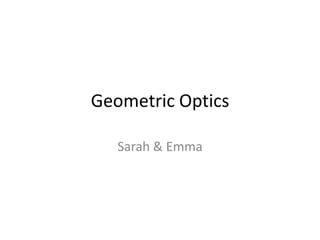Geometric Optics
- 1. Geometric Optics Sarah & Emma
- 2. i. Law of Reflection • Angle of incidence = angle of reflection • Incident ray, reflected ray and normal line all lie on same plane
- 3. Mirror Reflected ray Normal line Incident ray Object Angles of incidence Angles of refraction Source: ppt
- 4. Specular vs. Diffuse reflection • Specular reflection – reflection off smooth surface (i.e. mirror) • Diffuse reflection – reflection off rough surfaces (i.e. asphalt)
- 5. • A rough surface diffuses light because every individual light ray hits a point of the surface that is oriented at a different angle. This means they will reflect at all different angles. • Source: http://www.physicsclassroom.com/class/refln/U13L1d.cfm
- 6. ii. Refraction • Bending of light – light bends when it passes from one medium to another • The boundaries where refraction takes place are called interfaces Glass interfaces Light
- 7. nglass=speed of light in vacuum/ speed of light in glass ≈speed of light in air/speed of light in glass • These two “index of refraction”s are the same to 3 sig figs
- 8. Snell’s Law • For a given substance, the ratio sin(angle of incidence)/sin(angle of refraction) is a constant Angle of incidence (θair) Angle of refraction (θglass) Normal line Light
- 9. Angle of incidence (θair) Angle of refraction (θglass) Normal line Light nglass = sinθvacuum/sinθglass = vvacuum/vglass ≈ sinθair/sinθglass = vair/vglass
- 10. • If we add a substance other than air (glass & water instead of air & water)… θglass Glass Water θwater • nXsinθX = nysinθy= nzsinθz = … as long as the interfaces are parallel
- 11. • The denser the substance, the greater the index of refraction • As light goes from less dense to denser, it bends toward the normal (angle of incidence > angle of refraction) • As light goes from denser to less dense, it bends away from normal (angle of incidence < angle of refraction)
- 12. iii. Prism • Dispersion – separation of visible light into its different colors • Angle of deviation –overall refraction caused by passage of light ray through prism
- 13. Dispersion • Different colored lights have different frequencies • Therefore they travel through material w/ different speeds • This leads to different angles of refraction and the dispersion of light
- 14. Deviation • Angle of deviation – angle b/w incident ray and refracted ray that leaves prism θblue θred














